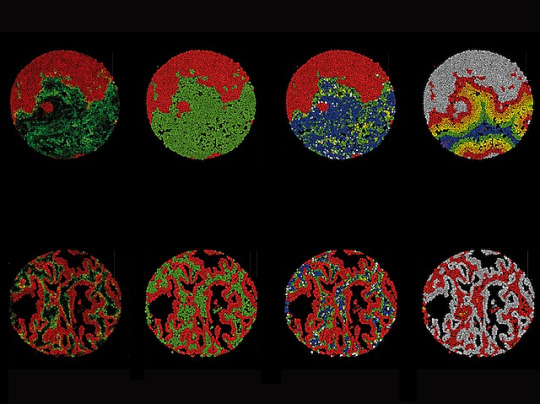#lung tumor
Explore tagged Tumblr posts
Text
youtube
#DX2 inhibition#lung cancer#nicotine-induced cancer#cancer therapy#oncogenic protein#nicotine addiction#smoking and cancer#tumor progression#molecular oncology#cancer research#apoptosis induction#targeted therapies#metastasis prevention#cell proliferation#lung tumor#oncology innovation#cancer treatment strategy#nicotine carcinogenesis#precision medicine#smoking cessation research.#Youtube
1 note
·
View note
Text


Kyle Crane's Bad Times Fuck Off Mixtape (Bad Times for Taff)
Step 1: Loot CDs Step 2: Find working CD player + Cassette Recorder Step 3: ♫ Step 4: ( ^◡^)っ ♡
Song index and Spotify Playlist under the cut.
I'm doing that bit where I run in circles in my head trying to build up a charge so I can express enough thanks for this gorgeous commission from @diaroza (Twitter: diar0za). Thank you!!


#Dying Light#Kyle Crane#Fan Art#Hold Still Babe#When you looking after a mom with dementia and lung cancer and brain tumors you sometimes need Kyle Crane to make you a mixtape#Spotify
256 notes
·
View notes
Text
lucifer!millie does not have many interactions with chuck before lucifer gets forcibly removed from the vessel, but a consistent theme in them is millie very aggressively pulling control away from lucifer. which is not so much ‘hey let me get between you and your shitty dad’ as it is ‘there’s an archangel inside me having a ptsd episode because you’re in front of him and i can fucking feel every second of that, it hurts, go the fuck away’
#i imagine feeling an archangel get triggered while they’re in your body is a bit like eating a stapler and then doing jumping jacks#which is to say. highly unpleasant. and extremely damaging to your internal organs.#look im sure SOME of the reason she does it is that she has some sympathy for lucifer about this.#they’ve been in the same body for. not a long time. but a bit. and they’re not *not* talking. that would be impossible.#but like the primary motivator of this *is* that when lucifer gets too stressed he starts unconsciously growing tumors in her lungs#and it fucking hurts#spn oc
12 notes
·
View notes
Text
.
#i swear to god if i wind up having a malignant lung tumor im going to flip my absolute shit#i don't even know when imaging will get back to me to schedule the appointment but it could be a few months before i can have it done#and get the results#so i get to just sit here with some very tiny but unknown thing inside me#and wait#love that for me#it is super small but so was the thing that killed my mom soooo
23 notes
·
View notes
Text
just found out my cousin has brain cancer🫠🫠
#she had lung cancer (i think)#but her scan from a month ago said she was clear#she had an mri last saturday tho and they found a tumor in her brain#idk what to do rn#𓆩♡𓆪 angel's thoughts 𓆩♡𓆪
5 notes
·
View notes
Text

Signs in Surroundings
Single-cell mapping of lung cancer samples reveals presence of a distinct subset of connective tissue cells called fibroblasts in the tumour surroundings (microenvironment) is associated with different outcomes for the patient – tumour-like fibroblasts with poor prognosis and inflammatory type with longer survival
Read the published research article here
Image from work by Lena Cords and colleagues
Department of Quantitative Biomedicine, University of Zurich, Zurich, Switzerland
Image originally published with a Creative Commons Attribution – NonCommercial – NoDerivs (CC BY-NC-ND 4.0)
Published in Cancer Cell, January 2024
You can also follow BPoD on Instagram, Twitter and Facebook
8 notes
·
View notes
Text
Just a friendly reminder: corporations are not your friend. Not those who you purchase from, or those who you work for. They do not care about you. They are much like Lovecraft's cosmic horrors: you are small and insignificant and meaningless to them. And they are unknowably massive monstrosities that will drive you to the point of madness.
#I found out today that my father has three brain tumors#I have next to no other info than that#but he had stage 3 lung cancer last year and has been in remission since about august#I called my supervisor (who I like) and informed him that I was taking emergency leave for friday and saturday to drive down to see him#he expressed his condolences and wished me well#but also had to tell me to make sure that my team was driving metrics in my absence#I know that corporate is breathing down his neck#but metrics are the ABSOLUTE least of my concerns right now and it took everything in me to bite back how angry hearing that made me#I'm so tired and drained right now
2 notes
·
View notes
Text
My ex kitten has officially been euthanized :(
#bernardo talks a lot#she had a tumor in her lungs from what I coulr gather#my ex (that got the cat's custody) said she was apathetic and anemic and then the vet said she could do chemo but would be very hard for her#since she has FelV#and FiV
2 notes
·
View notes
Text
I can't believe my mom is dying it's so fucking unfair
#it's so unfair to everyone...#this March just a bit of a tumor in her lung and lymph nodes... now all around her spine IN HER BRAIN just everywhere#people don't really survive metastatic brain cancer... like it doesn't get cured... I only just found that out#I just want her to see me do the things she's been wanting to see me do#unfair#I don't get it#it's all happening too fast...#I hate this
2 notes
·
View notes
Text

Os microplásticos têm menos de 5 milímetros — menores que um grão de arroz — e são onipresentes no meio ambiente. 🌎
#ecologia#ecology#plastic#plastic waste#plasticos#microplastics#microplasticos#saude#health#public health#saude publica#diseases#doencas#cancer#tumor#air#atmosfere#ar#atmosfera#lungs#pulmao#poluicao#polution#pollution#environment#meio ambiente#lixo#trash
1 note
·
View note
Text
youtube
#Perioperative analgesia#lung cancer#immune modulation#anesthesia techniques#surgical outcomes#cancer immunity#tumor progression#metastasis#opioids#regional anesthesia#epidural analgesia#nerve blocks#immune suppression#pain management#postoperative recovery#cancer surgery#patient outcomes#immunotherapy#anesthesia research#cancer survivorship.#Youtube
0 notes
Text
I could drag myself over coals for not taking my cat to the vet sooner. Fuck.
#the cancer almost certainly started in the one single tumor that couldve been removed#but now its in her lungs#itd be one thing if it was a surprised but i knew. i knew she needed to go to the vet. and i delayed for stupid reasons.#Aeroplanes talking#pet death //#she's not dead but i dont want to upset people
1 note
·
View note
Text
#Fine Needle Aspiration#Cytology#Biopsy#Diagnostic Procedure#Needle Aspiration#Tumor Analysis#Cancer Detection#Thyroid Biopsy#Breast Lump Aspiration#Lymph Node Sampling#Cellular Examination#Pathological Diagnosis#Histopathology#Non-surgical Biopsy#Benign vs Malignant#Tissue Sample#Microscopic Examination#Needle Biopsy#Aspiration Cytology#Clinical Diagnosis#Tumor Cells#Cytopathology#Sample Collection#Papanicolaou Stain#Guided Aspiration#Invasive vs Non-Invasive#Ultrasound-Guided FNAC#Lung Cancer Screening#Thyroid Nodule Evaluation#Cervical Cancer Screening
1 note
·
View note
Text
What Is Papillary Mesothelioma in 2024? | Discover
Introduction Papillary mesothelioma is a rare and generally less aggressive form of mesothelioma, primarily affecting the peritoneum, which is the lining of the abdomen. Unlike other types, it is often considered benign or of low malignancy, with a better prognosis. This article explores what papillary mesothelioma is, its symptoms, diagnosis, and treatment options.
Contact Us Now For a Free Consultation
1. What Is Papillary Mesothelioma? Papillary mesothelioma, also known as well-differentiated papillary mesothelioma (WDPM), is a subtype that develops in the mesothelium but has a better prognosis compared to other mesotheliomas.
Location: Most commonly occurs in the peritoneum.
Nature: Tends to be localized and slow-growing.
2. Who Is Most at Risk for Papillary Mesothelioma? While asbestos exposure is a risk factor, papillary mesothelioma can also occur without known exposure.
Age group: Often affects younger individuals compared to other types.
Gender: More common in women than men.
3. What Are the Symptoms of Papillary Mesothelioma? Symptoms can be mild and similar to other abdominal conditions, making it harder to diagnose early.
Common symptoms: Abdominal pain, bloating, and a feeling of fullness.
Advanced signs: Fluid buildup in the abdomen (ascites).
4. How Is Papillary Mesothelioma Diagnosed? Diagnosis requires a combination of imaging tests and biopsies to distinguish it from more aggressive forms.
Imaging: Ultrasound, CT scans for detecting tumors.
Biopsy: Needed for definitive diagnosis and to assess the nature of the cells.
5. What Are the Treatment Options for Papillary Mesothelioma? Treatment is usually less aggressive due to the slow-growing nature of this mesothelioma type.
Surgery: Often used to remove localized tumors.
Observation: In cases where the disease is stable, regular monitoring may be sufficient.
6. What Is the Prognosis for Papillary Mesothelioma? The prognosis is generally favorable, with many patients having a good quality of life.
Survival rate: Better than other mesothelioma types.
Focus on management: Regular follow-ups are important to monitor any changes.
Conclusion Papillary mesothelioma is a rare and often less aggressive form of mesothelioma, offering a better prognosis than other types. With proper diagnosis and treatment, individuals can manage the condition effectively. If you experience symptoms, consult a healthcare professional for early assessment.
FAQs
Is papillary mesothelioma always benign? Not always, but it is typically considered less aggressive than other forms of mesothelioma.
Can papillary mesothelioma spread? It is less likely to spread compared to other mesothelioma types, but monitoring is still crucial.
Is papillary mesothelioma linked to asbestos exposure? While it can occur without exposure, asbestos remains a known risk factor.
How long can someone live with papillary mesothelioma? Many patients live for years with proper monitoring and treatment.
What are the surgical options for papillary mesothelioma? Surgical removal of localized tumors is common, especially when the disease is contained.
Can papillary mesothelioma recur after treatment? There is a possibility of recurrence, which is why ongoing monitoring is recommended.
#mesothelioma#peritoneal mesothelioma#mesothelioma cancer#well-differentiated papillary peritoneal mesothelioma#mesothelioma law firm#mesothelioma article#mesothelioma attorney#mesothelioma treatment#mesothelioma stages#mesothelioma stage 4#peritoneal mesothelioma treatment#asbestos mesothelioma attorney#mesothelioma information#mesothelioma tumor#mesothelioma warrior#mesothelioma diagnosis#mesothelioma resources#mesothelioma help#mesothelioma lung cancer
0 notes
Text
Pneumonia/Water in the lungs is such an insanely metal cause of death for the greatest aquascaper of his generation
1 note
·
View note
Text
„Wir haben Tumore der Atemwege (Lunge), der Brustdrüsen, des zentralen Nervensystems, der Schilddrüse, des Kreislaufs und des Verdauungssystems. Es sind hinsichtlich der Sterblichkeit die Wichtigsten“ […] Viele Tumore traten erst nach 10, 15 Jahren auf. Und zwar nicht nur in erhöhter Zahl, sondern auch aggressiver. Wer beispielsweise zuvor einen Gehirntumor hatte, der im Frontallappen, Hinterhauptslappen oder Schläfenlappen lokalisiert war, hat ihn jetzt von frontal bis temporal und immer mehr davon. Tumore sind im wahrsten Sinne des Wortes zu Gehirnkrankheiten geworden.“
Prof. Danica Grujicic, Neurochirurgin, bis 2022 Direktorin des Instituts für Radiologie und Onkologie Serbiens, mutige Autorin vieler Studien und inzwischen Gesundheitsministerin
Laut dem Europäischen Krebsinformationssystem (ECIS) lag Serbien im Jahr 2020 mit einem Index von 150,6 Fällen pro 100.000 Einwohner an erster Stelle, während der europäische Durchschnitt bei 108,7 Fällen lag.
Lag die Zahl der jährlichen Krebserkrankungen in Serbien 1990 noch bei 9.899, so stieg sie im Jahr 2000 sprunghaft auf 22.123, 2010 auf 26.152 und 2011 auf rund 33.000 Fälle an. Heute erkranken jährlich 40.000 der rund 7 Millionen Einwohner an Krebs.
Aus 78.000 Tonnen verbranntem Sprengstoff und Raketentreibstoff und den Abgasen von über 150.000 Flugstunden der Bomber und Marschflugkörper wurden zusätzlich zu allen Chemikalien über eine Milliarde (1.000 Mio.) Kubikmeter Luftschadstoffe freigesetzt, so die Expertin. Angesichts der damaligen Klimadebatte ein zusätzliches Verbrechen. Diese Gesamtmenge an Kohlendioxid, Stickoxiden und unverbrannten Kohlenwasserstoffen war der größte Beitrag zur Luftverschmutzung und zum Treibhauseffekt seit dem Golfkrieg! „Es war eine neue Form der chemischen Kriegsführung, quasi ein Gaskrieg“, sagt Prof. Ursula Stephan. Ein Super-GAU sozusagen, eine Katastrophe außer Kontrolle. Vergleichbar mit Tschernobyl oder Fukushima.
„In dem Moment, in dem es zu einer Explosion kommt [ein Urangeschoss eine Panzerung durchschlägt], existiert Strahlung, danach sind es die Nanopartikel, die die Arbeit verrichten. Sie gelangen in Ihre Lunge, Ihren Verdauungstrakt und Ihre Nieren, und dann können Sie jeden Moment damit rechnen, dass ein Alphateilchen aus abgereichertem Uran, das 50-mal krebserregender ist als jedes andere, {…]in Ihrem Körper eine normale Zelle in eine bösartige Zelle verwandelt.“
Prof. Danica Grujicic
Erstmals setzte die NATO 1999 auch panzerbrechende Uranmunition ein. Während des 78-tägigen Krieges wurden 31.000 Urangeschosse mit ca. 10-15 Tonnen abgereichertem Uran an über 91 Orten verschossen. Hauptsächlich im Kosovo und in Südserbien. Bereits am 22. April 1999 machte die ARD-Sendung Monitor darauf aufmerksam.
Mehr als 10 Tage lang zog eine 20 km lange Giftgaswolke über die Vororte Belgrads in die Gemüse- und Kornkammern Serbiens. Die Konzentration von Vinylchlorid erreichte zeitweise das 10.600-fache des internationalen Grenzwertes. Als der Wind drehte, zog die Wolke weiter über Bulgarien, Rumänien und Ungarn. 550 Kilometer weiter südlich registrierten Wissenschaftler der griechischen Universitätsstation Xanthi hochgiftige Dioxine und polyzyklische aromatische Kohlenwasserstoffe.
Der militärische Aufwand der Operation ALLIED FORCE war entsprechend: 2.300 Luftangriffe auf 995 Objekte. Mit über 18.000 Kampfflugzeugeinsätzen, 420.000 Raketen, 1.300 Marschflugkörpern und 37.000 heute geächteten, aber in der Ukraine wieder eingesetzten „Streubomben“. Rund 200 Menschen starben allein durch sie, mehrere hundert wurden furchtbar verletzt.
Zerstört oder beschädigt wurden nicht nur 25.000 Wohngebäude, 470 Kilometer Straßen und 595 Kilometer Eisenbahnlinien. 14 Flughäfen, 19 Krankenhäuser, 20 Gesundheitszentren, 18 Kindergärten, 69 Schulen, 176 Kulturdenkmäler, darunter Klöster, und 44 Brücken. In der Nacht zum 23. April 1999 tötete die NATO bei einem gezielten Angriff auf ein Gebäude des staatlichen Rundfunks auch 16 Fernsehmitarbeiter.
„Alle Formen dramatischer Erkrankungen haben zugenommen. Die Sterilität bei Männern, Autoimmunkrankheiten, Fehlgeburten, die Aggressivität von Tumoren, Krebs auch bei Kindern. Es war ein nuklearer und chemischer Krieg, den die NATO 1999 führte.“
Prof. Danica Grujicic
Obwohl keine Zustimmung des UN-Sicherheitsrates vorlag, erteilte der damalige NATO-Generalsekretär Javier Solana dem Chef der alliierten Streitkräfte, US-General Wesley Clark, den Angriffsbefehl. 19 Staaten schlossen sich an.
Frei nach: "Es war ein nuklearer und chemischer Krieg, den die NATO 1999 gegen Serbien führte – heute hat das Land die höchste Krebsrate“ in NachDenkSeiten von Hartmut Sommerschuh am 04.06.2024. Den vollständigen Artikel im Wortlaut lesen oder hören: https://www.nachdenkseiten.de/?p=116144
#Infrastruktur#Interventionspolitik#Krankheiten#Morbidität#NATO#Serbien#Uranmunition#Angriffsbefehl#Sterilität#Autoimmunerkrankheiten#Fehlgeburten#Tumore#Krebs#AlliedForce#Giftgaswolke#Vinylchlorid#Dioxine#Kohlenwasserstoffe#Urangeschosse#Lunge#Verdauungstrakt#Nieren#Sprengstoff#Raketentreibstoff#Abgase#Luftschadstoffe#Krebserkrankungen#Atemwege#Lungen#Brustdrüsen
0 notes